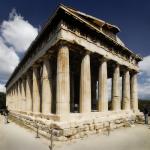|
This section contains 632 words (approx. 3 pages at 300 words per page) |

|
c. 400 B.C.E.–Before 326 B.C.E.
Sculptor
Leading Greek Sculptor.
Praxiteles of Athens was the leading Greek sculptor of the fourth century B.C.E. and introduced several innovations to the medium that significantly influenced Hellenistic sculpture. He more than likely belonged to a family of sculptors; his own sons, Cephisodotus and Timarchus, followed in his footsteps, and the fact that he named his first son Cephisodotus indicates that his own father was also Cephisodotus (given names skipped a generation). Praxiteles' father is likely the Cephisodotus who carved a famous statue of Eirene (Peace) and Ploutos (Wealth) which was set up in the marketplace in Athens in the 370s, perhaps after 374 B.C.E. when Athens made peace with Sparta. The statue betrays some of the characteristics for which Praxiteles would be famous, including a humanizing of the gods that is a departure from the more...
|
This section contains 632 words (approx. 3 pages at 300 words per page) |

|




